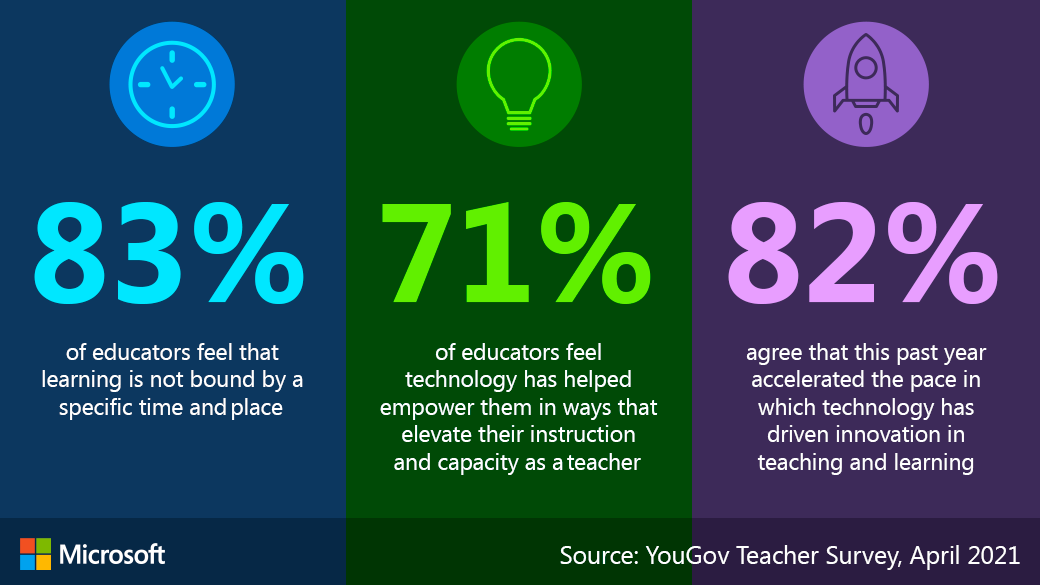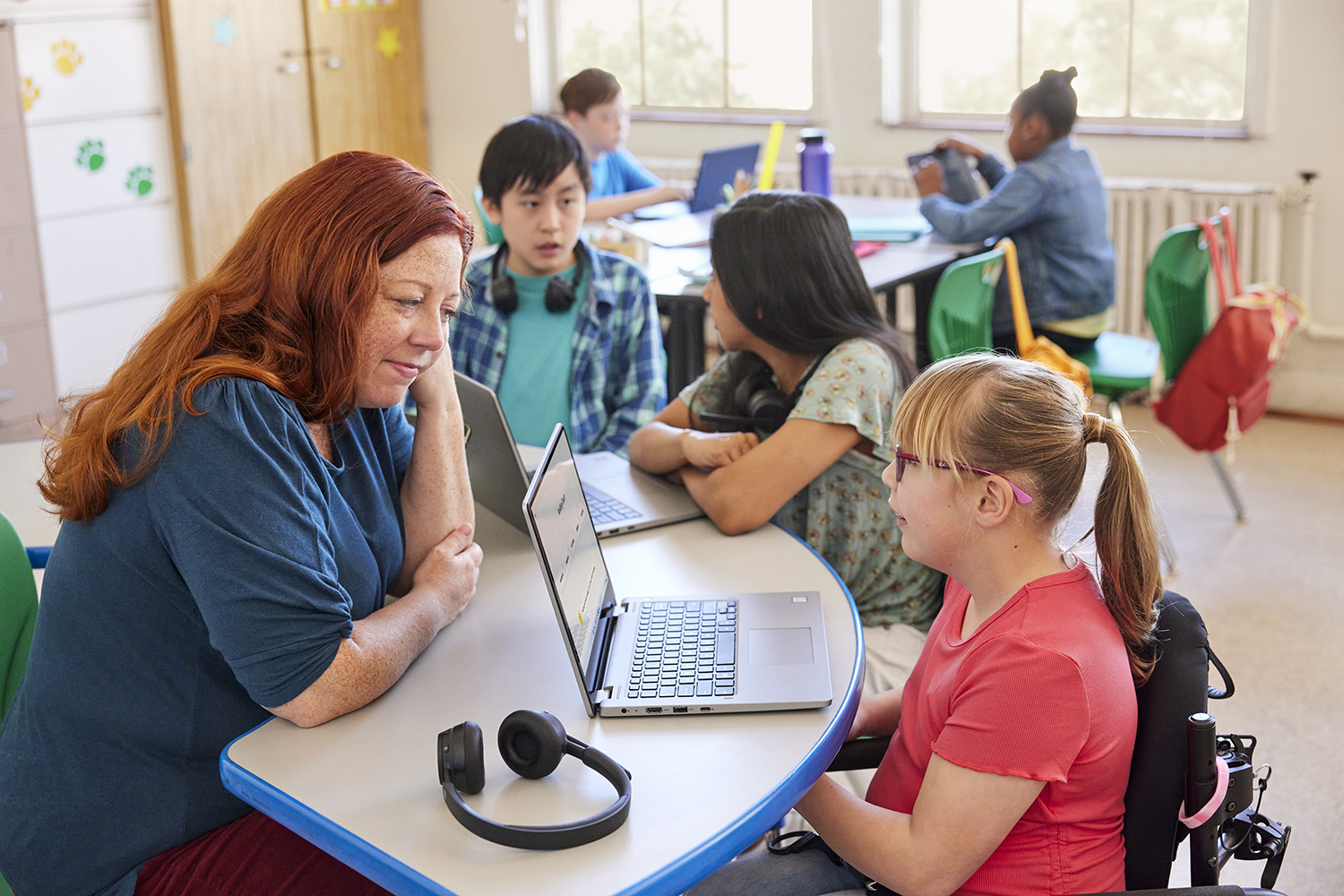At a glance:
- We send a heartfelt “THANK YOU!” to all the teachers around the world for the incredible work you continue to do, finding new ways to engage and inspire students despite continuing challenges and uncertainty.
- During remote and hybrid learning, teachers have innovated by integrating technology and learning to engage students. 82 percent of educators agree that this past year accelerated the pace at which technology has driven innovation in teaching and learning.
- As schools reimagine learning, several key elements are being brought together to form a holistic approach to learning: student centricity, skills focus, social learning, safety and security, and scalability. There are several technologies that are critical to support learning, including collaborative online environments, analytics and feedback tools, and inclusive, immersive experiences that support deep understanding of complex concepts.
- To further support teachers and students on this journey, today we’re announcing new apps and features including Reading Progress, which is designed to personalize learning and boost student success.
- From new features like Group Assignments and third-party app integrations in Microsoft Teams, to a more seamless connection with learning management systems (LMS), we are announcing 30+ additional enhancements that empower educators and support students in their classroom experience.
Today is National Teacher Appreciation Day, and I’d like to start by expressing my personal thanks and gratitude for everything teachers do. Despite the challenges of the past year, you continue to show compassion, resilience, and unwavering commitment to each student and their individual learning journey.
For the past year, teachers have leveraged technology in innovative ways to keep students engaged. Technology went from being a temporary lifeline to facilitate connection in remote and hybrid learning, to a fully integrated part of many virtual and in-person classrooms. According to a recent YouGov survey commissioned by Microsoft, 71 percent of K-12 educators say technology has helped them improve their instruction and expanded their teaching capacity.
To continue to support teachers and students, today we’re introducing new tools and updates designed to support the five key areas that help teachers create a holistic learning environment and move education forward: student centricity, skills focus, social learning, safety and security, and scalability.
Enabling student-centered learning with Reading Progress
In remote and hybrid learning, studies show that reading skills have declined for some students. In order to reverse learning loss, educators are seeking ways to evaluate where their students are, and help them advance at their own pace. We are introducing a new, free tool to support learners in reading.
Introducing Reading Progress
Whether readers are learning a new language or educators are trying to improve students’ general reading comprehension, Reading Progress enables students to practice their skills in a secure, student-centric environment.
With Reading Progress, educators can:
- Save time by creating reading fluency assignments for either the entire class or for individual students to complete independently. Teachers can also review assignments quickly and accurately with built-in auto-detect features for the English language (with adjustable pronunciation sensitivity) that analyze results. The tool also allows teachers to jump to any part of the recording to review detected words and passages.
- Visualize reading progress thanks to integration with the Education Insights dashboard. Educators can see a holistic view of students’ progress with trends and data, from accuracy rate and correct words per minute, to mispronunciations and omissions for individual students or the entire class. Insights provides actionable feedback educators can use to guide class progress, and identifies areas for one-on-one attention. Educators can also share data and examples with school-approved literacy coaches, speech pathologists, tutors, and parents.
- Engage students in independent practice on their own time. Using both audio and video, students can work at their own pace, record as many times as they’d like, and make progress without pressure. The built-in Immersive Reader also helps provide accessibility and clarity.
Reading Progress is built on the solid scientific foundation of oral repeated reading and close monitoring by the educator. It allows educators to provide personal attention to each student while at the same time dealing with a whole classroom full of students.
Tim Rasinski, Professor of Literacy Education at Kent State University
Available ahead of the next school year, Reading Progress is free for all students and teachers using Microsoft Teams for Education, and is compliant with the Family Educational Rights and Privacy Act (FERPA).
Announcing new tools for student engagement in the classroom
We’re enhancing Teams and other tools to help educators unlock digital experiences that complement and enrich in-person learning. These new, free offerings will be available ahead of the next school year and were inspired by insights from education experts, system leaders, educators, and students alike.
- Group Assignments: Educators will be able to organize their students into assignment groups so they can work together to create, collaborate, and submit the same work, allowing students to experience the power of teamwork firsthand.
- Use your favorite apps in Assignments: Teachers know that some apps really create that “a-ha” moment, engaging students, and inspiring deeper learning. Educators will now be able to issue assignments from a variety of third-party apps directly in Teams, saving time and increasing student creativity.
- Calendar integrations: New calendar integrations allow students to see when their classes are and when assignments are due in their Teams and Outlook calendars. This way, students can see all the important information—where they need to be and what they should do to keep learning—in one place.
- LMS updates: To help save time for educators and create a more seamless experience, Microsoft is working with leading learning management system (LMS) providers such as Instructure and Blackboard to deepen and improve integrations between the LMS and Teams, Teams meetings, and OneDrive. Additionally, our LMS partners are working with Microsoft to bring their own unique capabilities into Teams.
Making learning more engaging and fun
Educators know that immersive experiences deepen learning, and they’re always seeking different ways to keep students actively engaged.
Our recent YouGov study revealed that 80 percent of educators believe resources that have a gaming component increase student engagement and deepen understanding of various subjects. To provide more opportunities for students to play and learn inside and outside the classroom, we’ve added some new features to Minecraft: Education Edition.

- Enrich the Minecraft: Education Edition experience with Teams and Flipgrid: Based on input from educators, we’ve added the ability for Minecraft: Education Edition to integrate seamlessly with Teams. Within a Minecraft world or lesson, educators can now embed a Flipgrid topic, Forms quiz, or assessment tool using new resource links. Students in a Minecraft lesson can open a Flipgrid Topic, record and share their creation, and invite others to join a world they’ve created—with just a few clicks.
- Minecraft: Education Edition for Camps and Clubs: We’re also introducing Minecraft for Camps and Clubs, which allows learners to use Minecraft: Education Edition outside the classroom. Beginning this summer, camps, clubs, homeschool organizations, and nonprofits can purchase licenses for Minecraft: Education Edition to support critical thinking, collaboration, and game-based learning for all ages. This summer, Microsoft Stores will host several amazing camps and training sessions using Minecraft: Education Edition.
Supporting student well-being
Emotional well-being is key to student success, and research shows that approaches to support student well-being are in high demand, but low supply.i After the disruptions of the last year, it’s even more important that educators understand the complexities students face, their emotional state, and their motivations in order to help them navigate challenges.ii
In our recent YouGov survey, we found that 81 percent of educators feel it is very important to check in regularly with students to find out how they are feeling.
Technology can play an important role in helping teachers connect with and better understand their students, as well as facilitate students’ development of social-emotional skills. These new tools are designed to do just that.
Reflect, a free app in Microsoft Teams, provides a way for educators to create regular check-ins with individual students or classes to let students share how they are feeling. It helps students identify and label their emotions, and can build students’ emotional vocabulary and improve their ability to recognize and understand how their emotions may impact their learning. In addition, it can help teachers better identify the needs of individual students.
Embedded tools in OneNote and Teams, such as praise badges and sticker packs, can also help students and educators feel more connected and foster growth of effective relationships. We’ve heard from educators that Flipgrid has been invaluable over the past year, helping build students’ confidence and helping educators facilitate valuable learning conversations in and beyond the classroom.
Enabling secure classrooms
With more learning taking place outside the physical classroom, the increase in digital traffic and connected devices presents new challenges: from malicious attacks, to uninvited guests in the digital classroom. And as students return in-person, physical safety is also essential.
To support students’ safety in both digital and physical spaces, we’re introducing Supervised Chat in Teams. Available later this May, this feature will allow designated educators to initiate chats with students while preventing students from starting new chats unless an appropriate educator is present. Supervisors are not allowed to leave chats and other participants are not allowed to remove them—meaning students can engage in secure discussions, enabled and monitored appropriately by school staff.
Teachers’ insights and ideas are driving positive changes in education
When schools moved online last year, teachers made—and continue to make—superhuman efforts to help all students stay engaged in learning. They identified and filled gaps, found ways to connect with everyone in their classes, worked together to address challenges, and developed strategies to transform education for a new era.
In our YouGov survey, more than eight in 10 educators told us that the past year has shown that learning is not bound by a specific time and place, and 82 percent said technology has accelerated the pace of innovation in teaching and learning.
Actually, it’s teachers who have proven that learning can happen anywhere, and teachers who led the acceleration of innovation in education, supported by technology. Once again, THANK YOU to teachers everywhere. You have made an incredible difference in students’ lives by keeping them going throughout all the change and uncertainty, connecting with them, and inspiring them to be creative, confident, and optimistic whether they’re learning in a physical classroom, at home, or somewhere else.
Happy Teacher Appreciation Day…and THANK YOU!
iEmotion and Cognition in the Age of AI,” The Economist Intelligence Unit
ii“Learning Forward” Teacher/Student Survey. YouGov, December 2020










